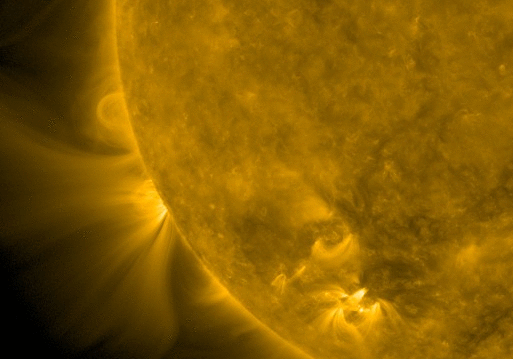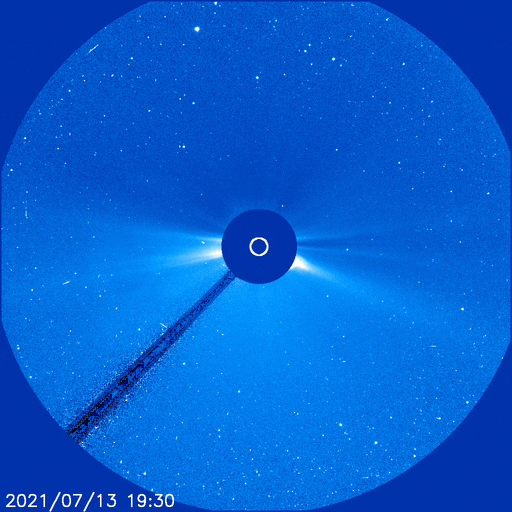However, it's not "global warming!" The planet may well have recorded its hottest June and July ever but May was one of the coldest ever for the northern hemisphere.
This week alone, parts of South Africa Australia, and Brazil have suffered record-breaking cold and snow. The severe cold currently gripping much of the Southern Hemisphere is thought to be because low solar activity is weakening the jet streams.
Whether the solar activity is weakening, or strengthening, or causing irregularities to the jet stream, I don't know, I'm no expert but the jet streams have been acting very strange recently and are indeed responsible for most of the crazy weather our planet has been witnessing recently.
But here is the caveat, Solar Cycle 25 has so far, in its short life often been punching above its weight!
According to Spaceweather.com, a CME might sideswipe Earth's magnetic field later today. NOAA forecasters say the glancing blow could spark minor G1-class geomagnetic storms. A minor G1-class storm is nothing to worry about, however, recently our star has been anything but quiet.
NASA and ESA satellites have been observing a very unstable far side of the Sun since July the 12th with multiple CME's exploding away from the far side of our star, indicating a large explosive sunspot group could be turning toward Earth.
On July the 19th Spaceweather.com reported that the southeastern limb of the sun was seething with activity see gif below. During the late hours of July 19th, Earth-orbiting satellites detected multiple long-duration solar flares as glowing masses of plasma and magnetic arches surged into view. NASA's Solar Dynamics Observatory recorded the action:

The source of the turmoil is one or more sunspots hidden behind the limb of the sun. They won't remain hidden for long. The sun's rotation is turning the 'spots toward Earth, and we should be able to see them in the next day or two.
The eruptions of July 19th also hurled a CME into space: The storm cloud will not hit Earth. Future CMEs might, however, as the underlying blast site rotates in our direction later this week.
A few days earlier an explosion on the far side of the sun was so powerful, we could feel it here on Earth. It happened on July 13th. The debris emerged in a circular cloud known as a ‘halo CME‘:

Above: The July 13th CME imaged by SOHO coronagraphs
When space weather forecasters first saw this explosion, there was a moment of excitement. It appeared to be heading directly toward Earth. However, data from NASA’s STEREO-A spacecraft indicated otherwise. The CME was heading directly away from us–a farside event.
Now for the interesting part: Although the explosion occurred on the far side, separated from Earth by the massive body of the sun, it still peppered our planet with high-energy particles. The Energetic and Relativistic Nuclei and Electron (ERNE) detector onboard SOHO recorded a surge in radiation not long after the CME appeared.
On July the 3rd sunspot AR2838 fired off the first X-class flare of Solar Cycle 25 it was the first x-class flare recorded since September 2017 and took the experts by surprise, it had come out of the blue.
A Solar Killshot
Had the two massive solar eruptions on the far side of the sun had been facing Earth this week our civilization would have been in deep trouble. According to Ben Davidson of Suspicious Observers, the massive solar eruptions were capable of causing electrical armageddon here on Earth and sending out technological world back to the stone age.
The massive CME, (coronal mass ejection, solar flare) called the Carrington Event, which happened back in 1859 was so strong it set fire to telegraph poles and buildings as well as giving telegraph operators electric shocks.
The problem for us in 2021 is we don't have the same strong and safe magnetic field protecting our planet as we did back in 1859.
Experts claim a repeat of the Carrington event frying our technological world of today would destroy our electrical-based civilization. Earth's magnetic shield is fading rapidly, we are down by about 25% in protection which is why monitoring the action of our sun is of the very utmost importance.
There would be no coming back from a massive solar flare. The chaos and panic would outway any positive organized response. As I mentioned early in this article, Solar Cycle 25 is still in its fledgling stage but solar activity is expected to 5-to-10 fold in the coming 3 years and Earth's magnetic field isn't getting stronger.
A Near Miss: A sign from Heaven... 2012 the year the world was supposed to end almost did!
If an asteroid big enough to knock modern civilization back to the MIDDLE AGES appeared out of deep space and buzzed the Earth-Moon system, the near-miss would be instant worldwide headline news. Eight years ago, Earth experienced a close shave just as perilous, but most newspapers and the tv media didn't mention it. The "impactor" was an extreme solar storm, the most powerful in as much as 150+ years. "If it had hit, we would still be picking up the pieces," says Daniel Baker of the University of Colorado.
The powerful coronal mass ejection (CME) tore through Earth's orbit on July 23, 2012. Fortunately, Earth wasn't there. Instead, the storm cloud hit the STEREO-A spacecraft. "I have come away from our recent studies more convinced than ever that Earth and its inhabitants were incredibly fortunate that the 2012 eruption happened when it did," says Baker. "If the eruption had occurred only one week earlier, Earth would have been in the line of fire and would have suffered "insurmountable damage to its electronic infrastructure."
Extreme solar storms pose a threat to all forms of high technology. They begin with an explosion--a "solar flare"—in the magnetic canopy of a sunspot. X-rays and extreme UV radiation reach Earth at light speed, ionizing the upper layers of our atmosphere; side-effects of this "solar EMP" include radio blackouts and GPS navigation errors. Minutes to hours later, the energetic particles arrive. Moving only slightly slower than light itself, electrons and protons accelerated by the blast can electrify satellites and damage their electronics. Then come the CMEs, billion-ton clouds of magnetized plasma that take a day or more to cross the Sun-Earth divide. Analysts believe that a direct hit by an extreme CME such as the one that missed Earth in July 2012 could cause widespread power blackouts, disabling everything that plugs into a wall socket. Most people wouldn't even be able to flush their toilets because urban water supplies largely rely on electric pumps. Full story
To make matters worse, geologists have been expressing concerns about the magnetic field that shields Earth from deadly solar radiation. In 2019, when the US National Oceanic and Atmospheric Administration was forced to update its World Magnetic Model a year early after finding that the magnetic north pole was rapidly moving out of the Canadian Arctic and toward Siberia.
The US National Aeronautics and Space Administration is tracking an immense, growing, and slowly splitting "dent" in the Earth's Magnetic field. The area, known as the South Atlantic Anomaly, is situated in the southern hemisphere between South America and the southern Atlantic Ocean off the coast of southwestern Africa. According to recent NASA monitoring and modeling, the area is expanding westward and becoming weaker and expected to completely split into two separate cells, each spanning thousands of kilometers across, very soon. Full story
The question here folks is, "when," and not if...


No comments:
Post a Comment